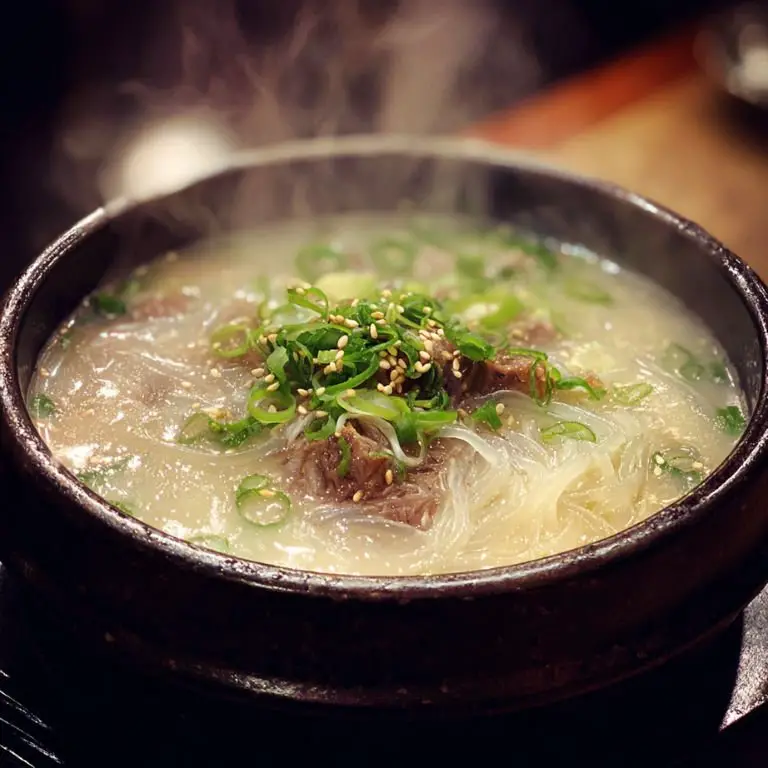If there’s one dish that embodies the soul of Korean comfort food, it’s ox bone soup, especially when infused with tender glass noodles and deeply aromatic garlic. This bowl of milky, collagen-rich broth brings the healing warmth of traditional Korean soups and stews to life. Known as Seolleongtang in Korea, this version adds soft glass noodles and fragrant garlic to create a satisfying fusion that feels like a long hug from your halmoni (Korean grandma). Whether you're exploring more korean soup recipes or just looking to elevate your bone broth game, this dish is a nourishing experience that deserves a spot in your dinner rotation.
Soul-Warming Ox Bone Soup with Glass Noodles and Garlic
Prep Time 30 minutes mins
Cook Time 8 hours hrs
Total Time 8 hours hrs 30 minutes mins
Course Main Course
Cuisine Korean
Large stockpot or Dutch oven Essential for the long simmering process. A heavy-bottomed pot retains heat well and prevents scorching.
Crockpot or slow cooker A fantastic alternative if you want to make a crockpot Korean beef or bone soup version with minimal attention. Just let it simmer overnight.
Fine mesh strainer For skimming and straining the broth.
Large Mixing Bowl To soak the bones and later to collect strained broth.
Soup ladle For serving, and for skimming fat during cooking.
For the Broth
- 3 lbs ox bones ideally knuckle and marrow bones, or a mix
- 1 lb beef shank or brisket optional, for extra richness
- 1 large onion peeled
- 1 whole head of garlic halved horizontally
- 1- inch piece of ginger sliced
- 2 green onions whole, for broth
- Water enough to submerge bones completely
For the Soup
- Cooked beef from the broth slice or shred
- 1 tbsp minced garlic
- 1 tsp sesame oil
- Salt to taste
- Black pepper to taste
- 3 oz glass noodles dangmyeon, soaked in warm water for 20 minutes
- 2 green onions finely chopped (for garnish)
Soak and Clean the Bones
Soak the ox bones in cold water for at least 2 hours (overnight is even better), changing the water a few times. This removes excess blood and results in a cleaner broth.
Blanch the Bones
Bring a large pot of water to a boil. Add the soaked bones and boil for 10 minutes. This step removes impurities. Drain and rinse the bones under cold water. Scrub off any gunk and rinse the pot as well.
Start the Broth
Place the cleaned bones back into the pot. Add the onion, ginger, garlic, and whole green onions. Pour in enough water to completely submerge the contents (about 14–16 cups). Bring to a boil, then reduce to a gentle simmer. Skim off any scum that rises to the top during the first hour.
Simmer Low and Slow
Let the broth simmer for 6–8 hours, adding water as needed to keep the bones submerged. The longer it simmers, the milkier and richer your broth becomes—this is the essence of a traditional korean beef bone broth or even a simplified version of korean oxtail soup.
Strain and Chill
Remove the bones and meat. Strain the broth through a fine-mesh sieve. Let it cool slightly, then refrigerate until the fat solidifies at the top. Skim off the fat and reserve the broth.
Prepare the Soup
Bring the broth back to a simmer. Add the soaked glass noodles and cook until just soft, about 5 minutes. Stir in the minced garlic and sesame oil.
Serve
Portion the noodles into bowls, ladle over the hot broth, and top with sliced beef. Garnish with chopped green onions and a sprinkle of black pepper. Season with salt to taste at the table.
Pairings
Ox bone soup with glass noodles is a gentle, soothing dish, so pairings should enhance without overwhelming.
- Kimchi – A must-have with any korean beef soup. The acidity and heat balance the richness of the bone broth.
- Steamed white rice – Scoop some into your soup or eat it alongside to make the meal heartier.
- Korean banchan (side dishes) – Include dishes like pickled radish, seasoned spinach, or kongnamul (soybean sprouts).
- Cold barley tea – A refreshing palate cleanser that also aids digestion.
Looking for a full-on Korean feast? Serve this soup alongside a crockpot Korean beef dish or Korean chicken stew for a deeply satisfying dinner.
FAQs
1. What kind of beef bones should I use?
Knuckle bones, marrow bones, and neck bones are ideal. If you want something more meaty, toss in some beef shank or brisket. These create the base for many beef bone broth soup recipes and are commonly used in Korean bone broth or even Korean pot roast for flavor.
2. Can I make this with pork bones instead?
Technically yes, though that shifts it into the territory of pork bone soup (Gamjatang-style). It will be equally delicious but have a slightly different flavor profile. Stick to ox or beef bones for a more traditional Korean beef bone broth soup.
3. Can I make this vegetarian?
This dish is inherently meat-based, but if you’re after the comforting essence of korean soup recipes, you might want to explore korean tofu soup or a hearty mushroom-based version. You won’t get the same collagen-rich body, but it will still be tasty.
4. Do I have to use glass noodles?
Glass noodles (dangmyeon) are traditional and lend a springy texture that works beautifully in this soup. However, you can substitute with rice noodles or even udon if you’re craving a different take. For a twist, add them to Korean noodle soup or even a Korean chicken soup base.
5. Is this similar to other Korean dishes like oxtail soup or seolleongtang?
Absolutely. In fact, this recipe draws from the same tradition as Korean oxtail soup and other Korean beef stew styles. The difference here is the addition of garlic and noodles, making it a cross between classic bone soup and a Korean noodle soup.
